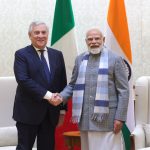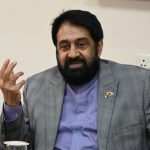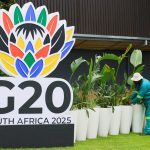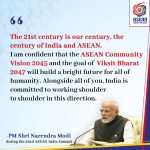 It’s time for making and remaking of India, an ancient rainbow civilisation transforming into a modern nation and an emerging powerhouse that is spawning a new narrative of renaissance, resurgence and renewal. The India Story is back in global circulation, as his ongoing trip to Europe shows. The IMF and the World Bank have already predicted that India’s economic growth will surpass that of China’s by 2016-2017, a prognosis that has been reinforced by Asian Development Bank and other trend-trackers.
It’s time for making and remaking of India, an ancient rainbow civilisation transforming into a modern nation and an emerging powerhouse that is spawning a new narrative of renaissance, resurgence and renewal. The India Story is back in global circulation, as his ongoing trip to Europe shows. The IMF and the World Bank have already predicted that India’s economic growth will surpass that of China’s by 2016-2017, a prognosis that has been reinforced by Asian Development Bank and other trend-trackers.
The Economist has encapsulated this new mood of ‘India Optimism’ in its recent cover story entitled “A chance to fly.” The prestigious British magazine says India has a rare opportunity to become the world’s most dynamic big economy,” but adds on a cautionary note: “The potential is there; the question has always been whether it can be unleashed.”
If the potential of 1.2 billion people of India and their surging dreams has to be realised, the Modi government in India will have to walk the talk on second-generation economic reforms (and it is already doing so by going ahead with crucial reforms in a host of areas, including raising the FDI cap in insurance and telecom). But the success of the India story in the coming months and years will also depend on how New Delhi leverages its growing global stature and harnesses its external relationships and multiple strategic partnerships through smart diplomacy to stimulate an Indian renaissance.
Make in India
Diplomacy is the art of the possible. If successful and effective diplomacy is about reigniting the spark in old relationships, winning new friends, breaking new grounds, and shaping the outcomes in the international arena to promote the country’s enlightened national interests and development, then the 11-month old Narendra Modi government scores high as it surges ahead with “a new vision and new vigour,” dovetailing diplomacy and development to fructify the potential of the India story.
‘Diplomacy for Development’ could fittingly serve as the overarching frame for India’s foreign policy thrusts under the Modi government. If one were to sift through cross-cutting themes during Prime Minister Modi’s foreign travels in the last few months from Tokyo and New York to Port Louis and Colombo, some strands stand out. First, the Make in India campaign, which was launched last year, has emerged as the centerpiece of India’s multifarious engagements with countries around the world. The campaign is designed to build and bolster domestic industrial base for manufacturing and to raise the share of manufacturing in the country’s GDP. It’s underpinned by the premise that India can fly only when it is supported by robust indigenous manufacturing base and capabilities.
In the military sphere, the Make in India has acquired a new traction. Policy paralysis that had crippled the procurement process under an overcautious and diffident defence minister under the previous government has given way to concrete decisions: the government has liberalized FDI in defence and is also looking to regularize middlemen to fast-track procurement. In external defence engagements, the new dispensation is looking to deepen the template of co-production and co-development with its key partners, including the US, Russia, France and Israel.
Smart Cities, Smart Diplomacy
Second, the Smart Cities project has acquired a powerful resonance in the country’s foreign policy outreach and underlines once again that foreign policy is increasingly about boosting domestic capacities and capabilities. Ever since Mr Modi declared his mission to build 100 smart cities in India, he has been proactively seeking support of India’s key partners, including the US, Japan, Singapore, China and Australia, in shaping this project which has the revolutionary potential to transform the urban landscape of India. In this area, the government has scored some successes. Japan has agreed to help develop the scared city of Varanasi into a smart eco-friendly city. India and the US have already signed agreements on the US companies deploying their expertise and technologies to help transform Allahabad, Ajmer and Visakhapatnam into smart cities. The agreement involves the US partnering in the transformation of the three cities as a knowledge partner in the areas of traffic management, solid waste management, garbage disposal, and water storage.
In pursuit of world-class infrastructure, the Indian government has shown a refreshing pragmatism by shedding geopolitics aside and enlisting the support of whoever has the necessary wherewithal and expertise. For example, India and China may have outstanding differences on a host of issues, including the long-standing boundary dispute, but this has not prevented India from reaching out to the cash-rich China and seeking investments and expertise in the ongoing project of infrastructural transformation of India. Thus, India has managed to seek support of both China and Japan, sworn rivals in the Asia hemisphere, for the project of economic rejuvenation of the country. Japan has pledged $35 billion package for investments in India and China has pledged $20 billion for a host of projects over the next few years. Put together, the US, China and Japan have pledged over $100 billion in FDI in 2014. The success of economic diplomacy will be to ensure that the pledged amount finally flow into the fund-starved country. In this context, Prime Minister Modi’s visit to Beijing in May will be crucial.
Breakthrough Diplomacy
Objectively, for India breakthrough diplomacy is only possible when the Modi government delivers on its promise of economic reforms, trims the fiscal deficit, stabilizes rupee and sustains economic growth to at least 7 per cent in the next fiscal year and step it up to 7-9 per cent over the rest of the decade. There is no half-house here; the Modi government has to go the whole hog if it wants India’s star to shine. The strong macroeconomic fundamentals, improving India’s ease of doing business rankings and revving up investors’ confidence with concrete time-bound reforms are the only way to keep the India Story in global circulation over the long term.
Smart Diplomacy: The Way Ahead
There is a lot going for India at this moment. It’s the only big emerging economy in the BRICS grouping which is doing well. The idea is to seize the moment, shed defensive foreign policy, take chances, and proactively engage the world in a web of trade, connectivity and win-win opportunities. This year, the UN will be celebrating the 70th year of its founding, and India is pushing to fast-track the long-standing project of reforms and expansion of the UN Security Council. In sync with its inclusive ethos, India has been arguing robustly to reform the world body to make it democratic and representative of current realities, and reflect the tectonic shift of power from the west to the east. India, the world’s largest democracy, Asia’s third largest economy equipped, can combine its hard power and soft power and position itself in the leadership role to shape the emerging global governance architecture. Slogans and dated ideologies won’t do; only development-focused diplomacy and proactive delivery on the much-promised reforms can take India where it richly deserves to be. It’s time for India to fly; and fly it must.
(Manish Chand is the founder-CEO and Editor-in-Chief of India Writes Network, www.indiawrites.org, and TGII Media Private Limited, a multi-media portal and company focused on international affairs and the India Story.)
- This article was first published on cfo-connect.com
Author Profile

- Manish Chand is Founder and Editor-in-Chief of India Writes Network (www.indiawrites.org) and India and World, a pioneering magazine focused on international affairs. He is CEO, Centre for Global India Insights, an India-based think tank focused on global affairs.
Latest entries
 India and the WorldDecember 12, 2025India-Italy bonding: Tajani’s visit raises the bar for business, maritime ties
India and the WorldDecember 12, 2025India-Italy bonding: Tajani’s visit raises the bar for business, maritime ties In ConversationNovember 26, 2025G20 is a Force for global Good
In ConversationNovember 26, 2025G20 is a Force for global Good articlesNovember 26, 2025Rescuing G20 from North-South divide: Ubuntu Moment
articlesNovember 26, 2025Rescuing G20 from North-South divide: Ubuntu Moment India and the WorldOctober 27, 2025Modi hails the century of India and ASEAN, backs ASEAN centrality
India and the WorldOctober 27, 2025Modi hails the century of India and ASEAN, backs ASEAN centrality







